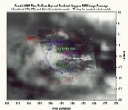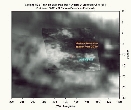| Time Delays | Actions |
|---|
| entry -4:22 | a timer triggers onboard electronics on as transmitter is set into low-power mode, awaiting the start of transmission. The probe is arriving at Mach 25, being heated, in the first moments, up to 21,600°F (12,000°C) |
| T0 | interface (entry) altitude (790 mi (1,270 km) above Titan's surface); Huygens enters Titan's atmosphere at a speed of 11,200 mph (18,000 km/h). Temperature is reaching 3,200°F (1,800°C) |
| T+00:04 | the probe tremendously deccelerates in a few minutes. When Huygens detects it has slowed down to a speed of 900 mph (1,440 km/h), the 8.5 ft-wide (2.6 m) pilot parachute deploys taking off the probe's rear cover |
| T+00:04:2.5 | once the rear cover taken off, the main, 27 ft-wide (8.3 m) parachute deploys. Huygens is now at 110 mi (180 km) above Titan's surface |
| T+00:05 | front shield released; Huygens begins transmission to Cassini. We are at 100 mi (160 km) above the surface |
| T+00:05:42 | a pilot parachute opens, exposing the instruments. Instruments-bearing booms extend. First panoramic pictures are taken |
| T+00:19 | main parachute separates (it would have slowed the probe too much as the batteries would not have stood the entire descent); it's replaced with the 10 ft-wide (3 m) drogue parachute. We are at 77 mi (125 km) of altitude |
| T+00:36 | Surface proximity sensor begings to work. Huygens will now probe its altitude itself, beginning at 37 mi (60 km) of altitude, as until now actions were triggered by timers |
| T+1:44 | the Gas Chromatograph Mass Spectrometer is the last instrument to be activated. The craft keeps spinning at a rate of 1 to 20 rotations per minute |
| T+2:17 | Descent Imager/Spectral Radiometer headlight turned on. The lamp allows instruments to see the surface |
| T+2:21 | touchdown (touchdown time may vary by plus/minus 15 minutes depending on how the descent was affected by the atmosphere and winds). Huygens has been designed to survive and gather data during the 3 minutes following touchdown whether the landing occurs on a solid, or a liquid, surface |
| touchdown+4:31 | Cassini stops collecting data as its landing site has dropped below the view of the Cassini orbiter |
| touchdown+5:01 | first data sent to Earth by Cassini |



